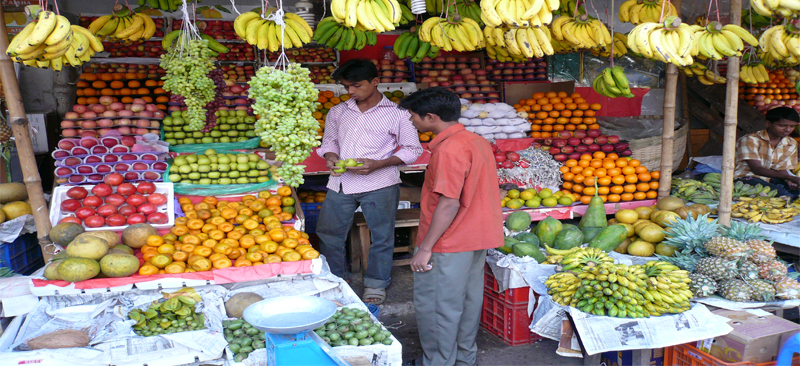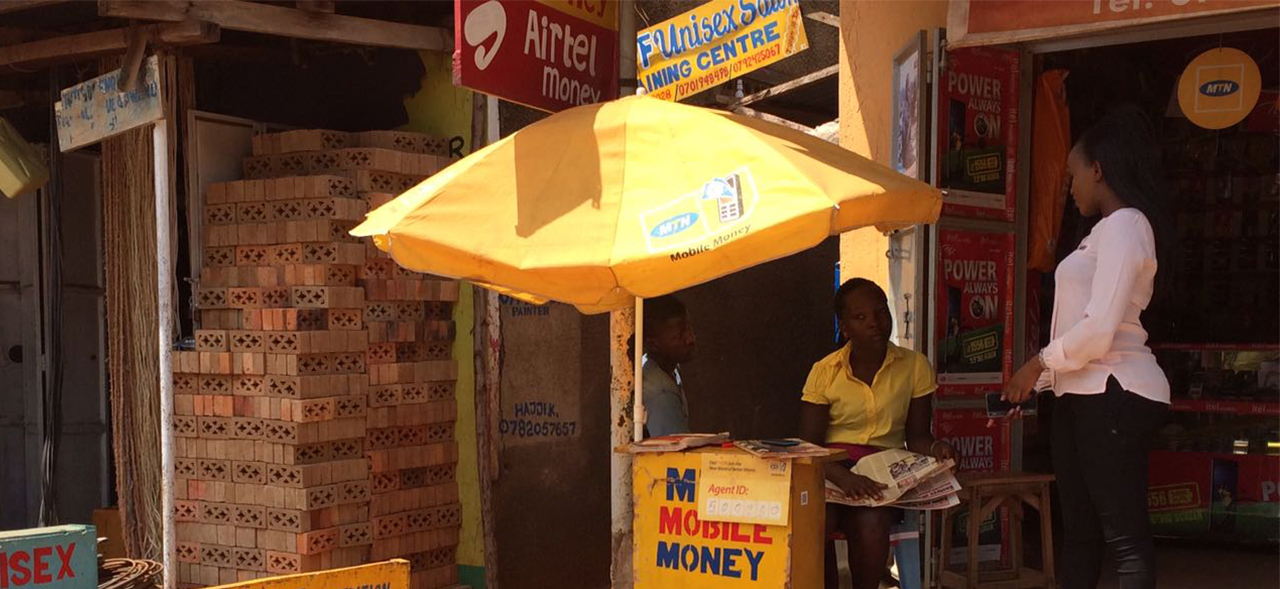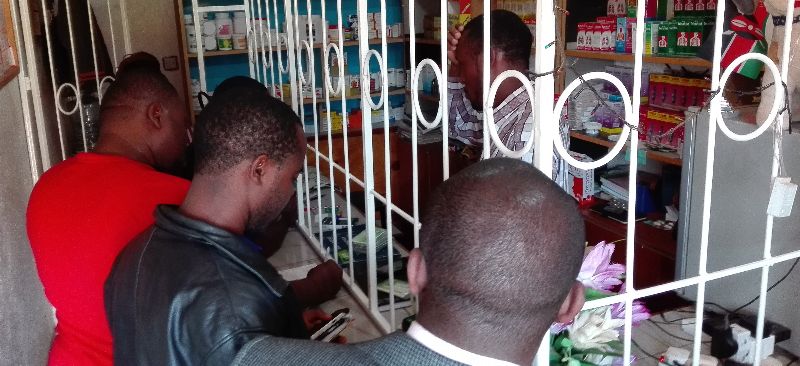This Slide Deck is a supplement to the Blog “How Are Mobile Money Agents Protecting Customers’ Data in Uganda?” (December 2022). The study presents findings from a research commissioned by CGAP, conducted in partnership with MicroSave Consulting (MSC), to identify good practices of responsible agents in safeguarding their customers’ data and the role that providers can play in promoting these practices in Uganda. It also examines how Uganda’s Data Privacy & Protection Act has helped to strengthen providers’ data protection practices.
Highlights of the webinar on “Financial Diaries research and it’s future
00:32 – 05:25 – Welcome note by Rahul Chatterjee, Senior Manager, Data & Insights, MSC.
01:21 – 02:27 – Introduction of Stuart Rutherford, Lead, Hrishipara Daily Diaries project.
02:28 – 03:26 – Introduction of Daryl Collins, Founder & CEO, Decodis.
03:28 – 04:24 – Introduction of Raunak Kapoor,Senior Manager, Indonesia programs, MSC
04:25 – 05:25 – Introduction of Anne Marie Van Swinderen, Founder & Managing Director, L-IFT.
05:37 – 05:46 The moderator asks the first question: Stuart, how did you develop the idea of financial diaries research? Has your approach to conducting diaries research changed since you started it? If yes, how?
05:50 – 07:50 Stuart answers, “David is the father of financial diaries, as he suggested the name.”
08:48 – 11:03 Stuart explains, “The first diaries focused on answering one question—do poor people have a financial life? Since then, the research question has become much broader.
11:13 – 11:25 The moderator asks the second question: Anne Marie, L-IFT has used Diaries research for quite some time. What are your thoughts on the feasibility of the Financial Diaries research methodology and its applications to a wide variety of research?
11:26 – 17:17 Anne Marie answers, “Financial diaries is a feasible research methodology that offers a two-way communication channel. After a certain period, participants come to you with questions and suggestions. Financial diaries projects help people make data-driven decisions. The diaries method can be used in various thematic areas, such as energy use, refugee issues, health implications, and mixed-livelihood strategies.”
17:51 – 18:51 Stuart comments, “The wheel has come full circle now, as sociologists used diaries as a sociological inquiry method in the past.
19:04 – 19:22 The moderator asks the third question: Daryl, you have managed country-focused financial diaries research, such as the Kenya financial diaries, and thematic area-focused diaries research, such as the smallholder farmers’ diaries. How are they different from each other? What points shall the researchers keep in mind while implementing them?
19:30 – 24:00 Daryl answers, “We could get regular data faster by sacrificing data granularity using technology. And for certain diaries research, you need specific tools—for example, a crop tracker for the farmers’ diaries.
24:26 – 24:47 The moderator asks the fourth question: Raunak, you have conducted two diaries research projects on enterprises in Indonesia—one on small corner shops and another on small firms. How do you think this helped the enterprises in improving their businesses? Has it also provided any input for enterprise owners to use their data efficiently for business development?
25:22 – 28:12 Raunak answers, “People became more aware of their financial behavior by maintaining diaries and also became confident in using digital tools. Many diarists continue to maintain diaries even after the project ends.
28:32 – 29:00 The moderator asks the fifth question: Stuart, you lead one of the world’s longest-running diaries research in Hrishipara that has been going on for more than seven years. How did you use this opportunity when COVID-19 started? Could you use the Hrishipara Daily Diaries Project to generate new insights about the impact of COVID-19 and how people coped with it? What plans do you have with the Hrishipara Diaries to unpack nonfinancial aspects of the lives of the diarists?
29:05 – 35:00 Stuart answers, “The Hrishipara Daily Diaries project could capture the financial life of the diarists before, during, and after COVID-19. The project could capture interesting insights, including the ‘Lives Day by Day’ section.”
35:24 – 35:39 The moderator asks the sixth question: L-IFT has been involved in a global project, small firm diaries, and a corner shop project across 11 countries. With that experience, what do you believe would be or should be the role of financial diaries research in the future?
35:46 – 40:50 Anne Marie answers, “[Financial diaries] will be more beneficial to the participants than the organization to manage and plan their financial behavior by maintaining diaries. It has the potential to provide data empowerment and help micro businesses develop their credit history.”
41:10 – 41:30 The moderator asks the next question: Raunak, you manage the diaries research in Indonesia on CICO agents. Why did you opt for a diaries approach for this? How do you think the insights from the agent diaries research will help policymakers, regulators, and financial service providers? What prospect do you see for this in the future?
41:35 – 46:05 Raunak responds by highlighting key insights from the agent diarist projects and how agent diaries can help service providers and policymakers test hypotheses.
46:27 – 46:51 The moderator asks the last question: Daryl, diaries research is a costly and resource-intensive affair. We know you have been experimenting with technology to optimize resource use. What lessons have you learned from this exercise? How do you foresee the role of technology in the future of diaries research?
46:57 – 52:00 Daryl responds, “Using technology, we can have a much larger sample size for diaries and qualitative research. Diaries can also be used to understand the nutrition practices of the people.”
52:28 – 55:19 – Summary of notes by Rahul Chatterjee, moderator of the session and Senior Manager, Data & Insights, MSC.
55:20 – 01:20:40 – Addressing questions from participants
01:21:05 – Note of thanks by Rahul Chatterjee
How are Mobile Money Agents Protecting Customers’ Data in Uganda?
“This agent is always reminding us to change our PINs from time to time, especially if we ever get to think that our PINs have been compromised. Also, he is constantly sharing information about the new ways the fraudsters are using to dupe people, so that we are aware and take care.” – Safina, 30, female customer, Uganda.
Mobile money agents can play a protective role when it comes to customers’ data. Recent qualitative research in Uganda conducted by CGAP, in partnership with MicroSave Consulting (MSC), identified good practices for responsible agents in safeguarding their customers’ data and the role that providers can play in promoting these practices. Such practices are especially important given CGAP’s recent global research showing that data misuse and fraud have increased massively over the past several years.
How do responsible agents help safeguard customer data?
We heard from many customers that mobile money agents often advise them to protect their PINs by not sharing them with anyone (including a spouse) and changing them regularly and to keep their distance from other customers while transacting. Some agents have also installed video cameras to deter fraudsters and informed their customers on how they can avoid falling prey to scammers. We found that most of the customers interviewed have been targeted by fraudsters and some have lost money.
“Fraud attempts are no big deal anymore since we are used to them. On average, we get one fraud phone call on a daily basis” said Joseph, a 40-year-old male customer we spoke with in Uganda.
Responsible agents ensure that customers form an orderly queue at their outlets, which are often small and can be easily crowded. This ensures the data privacy of customers as agents handle only one customer at a time. Some agents use a multi-fold gate at their kiosks, with space for only one customer by the counter, which serves to limit access to the agent’s logbook of customer transactions.
One innovative practice we learned about through our interviews was that some agents have joined local WhatsApp groups, helping them build an informal support group that can be used to share information about emerging fraud threats, data protection breaches and how to safeguard themselves and their customers. Providers also have their representatives join the WhatsApp groups to disseminate information on issues related to safeguarding customer data.
“I am aware of the mobile money guidelines around safeguarding customer information, keeping PIN safe, etc. I was informed of the guidelines and other rules to follow when I registered as an agent.” – Hasfa, 33, female mobile money agent, Kampala, Uganda
What are some responsible practices of providers to promote data protection?
Mobile money providers, including Airtel and MTN, conduct mass media campaigns around protection from fraudsters and safeguarding PINs. Customers interviewed mentioned receiving SMS messages with such warnings, along with noticing advertisements by providers on TV and on the radio. Providers also give their agents various marketing collateral on PIN management. Some mobile money providers, such as MTN Uganda, have gained GSMA’s Mobile Money Certification, a global initiative based on independent assessments of a provider’s ability to deliver secure and reliable services, to protect the rights of consumers, and to combat money laundering and the financing of terrorism. One important aspect of the Mobile Money Certification is to ensure data privacy and to protect customers against fraud.
As part of their adherence to Uganda’s Data Privacy & Protection Act of 2019 (DPPA), providers train their agents to collect only information relevant to the transaction. For example, sensitive information, such as customers’ religion or income, should not be requested to open mobile money accounts. We also heard about different types of mechanisms providers have put in place to identify, prevent, mitigate and investigate data misuse. For example, when sharing data with banks and partners, providers ensure that the data is anonymized to protect customer privacy. To investigate data fraud, mobile money providers regularly monitor transaction data and identify any data discrepancies in transactions.
What has been the role of the Uganda DPPA in strengthening customers’ data protection?
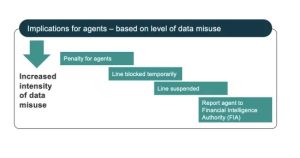
Mobile money providers strengthened their data protection practices after the implementation of the DPPA, which regulates personal data collection, processing, use, and disclosure, and applies to every person, entity or public body within or outside Uganda that collects, processes or holds personal data. As per the DPPA, providers have onboarded a dedicated Data Protection Officer who ensures adherence to the law. The Ministry of Information & Communications Technology (ICT) conducts monthly audits of providers to ensure compliance with the DPPA. Providers also levy penalties on agents based on the increased intensity of data misuse.
Figure 1: Implications for agents – based on level of data misuse
Gaps remain – what else can providers do to support their agents?
“Agents used to be rewarded if they had zero complaints, but this has been discontinued. There is no specific provision to incentivize agents for safeguarding data.” – Provider staff
While mobile money agents and providers in Uganda do a lot to promote and safeguard customer data, gaps remain, and data misuse and fraud are on the rise. Below are a few recommendations we have for providers on how they can continue to strengthen their agents’ data protection practices:
- During agent onboarding, train agents to be more transparent and share information with customers on how their data is used when customers subscribe to the service or buy a new SIM.
- Further emphasize data protection challenges and mitigation strategies during agent trainings, since agents do not typically receive focused training on customer data protection.
- Provide agents with additional support and marketing collateral on data protection, such as a ‘data protection communication toolbox’ for agents.
- Increase customer awareness on how their data is used and shared through more effective channels and content options for information dissemination to customers.
- Consider doing away with agent logbooks as agents already receive SMS confirmations of transactions, since logbooks can be a source of data exposure.
- Provide rewards and recognition to agents who receive minimum complaints about their conduct from customers. This will foster both competition and compliance of responsible practices among agents.
Want to learn more? Visit FinDev Gateway for the slide deck that provides further details on the findings.
This blog was first published on CGAP on 14th December, 2022
Highlights of the webinar on “climate-resilient agriculture, virtual breakfast club”: Where climate-action ideas brew
The following are timestamps of the meeting conducted on the 2nd of December, 2022, on “Climate resilient agriculture- virtual breakfast club.”
We organized a discussion session with a panel representing the funding side of the ecosystem. The panel discussed the following topics:
- What solutions can investors provide to address the challenges faced by Agtechs?
- How can we ensure that ecosystem support infrastructure is meeting the needs of Agtech startups?
- Are new platforms for information exchange between AgTech startups and investors needed?
- A few examples where investors have met the capital requirements of AgTechs.
Click on the timestamps from the webinar stream to hear specific segments.
00:18 – 00:40 – Welcome note by Partha Ghosh, Senior Manager at MSC’s climate change & sustainability practice.
00:41 – 06:48 – Introduction by the speakers Ashish Khetan, President, Indigram Labs Foundation Shreejit Borthakur, Senior Innovation Manager- Technology, IDH
08:33 – 08:47 – The speakers answered the first question: What solutions can investors provide to address the challenges faced by AgTechs?
09:04 – 09:52 – Shreejit Borthakur of IDH responds: “Trajectory of funding has changed. Till 2014, most of funding was going to mitigation but now as the exposure to climate change hazards has increased, there is a growing momentum towards adaptation and resilience.”
15:15 – 16:30 – Ashish Khetan from Indigram Labs Foundation responds: “Climate resilient agriculture could be put in buckets such as soil resilience, water management and food waste management.”
17:52 – 18:15 – The speakers answered the second question: Can you give a few examples of the types of investments you have made in AgTechs?
18:56 – 19:38 – Ashish Khetan from Indigram Labs Foundation responds: “Usually, Investors like to invest in startups that are at a revenue stage and not all businesses are venture capital friendly. But no business is a bad business.”
22:00 – 22:25 – The speakers answered the third question: How can we ensure that ecosystem support infrastructure is meeting the needs of startup AgTechs?
23:28 – 24:21 – Shreejit Borthakur of IDH responds: “As the focus on climate adaptation and resilience will increase, the investment vehicles dedicated to that will start being set up.”
24:35 – 25:05 – Shreejit Borthakur of IDH also responds: “Development stakeholders are pumping in patient capital to SMEs.”
22:27 – 23:04 – The speakers answered the fourth question: Are new platforms for information exchange between AgTech startups and investors needed?
26:22 – 27:15 – Shreejit Borthakur of IDH responds: “Ecosystem level interventions are required and India’s Agristack could be a gamechanger.”
28:05 – 28:28 – The speakers answered the fifth question: Is there a difference between investors interested in pure-play AgTech and investors focusing on climate resilient agriculture?
29:25 – 30:23 – Ashish Khetan from Indigram Labs Foundation responds: “From investor’s perspective, money alone cannot solve the problem. The ecosystem plays an important role.”
39:36 – 39:58 – The speakers answered the sixth question: Is there a difference between investors interested in pure-play AgTech and investors focusing on climate resilient agriculture?
41:01 – 41:20 – Ashish Khetan from Indigram Labs Foundation responds: “It is crucial that we go to a sector specific incubator if the founder is looking for some value addition rather than being all over the place.”
41:40 – 42:20 – Shreejit Borthakur of IDH responds: “Most of the funding going towards startups focused on adaptation rather than mitigation are from investors that have longer return horizon.”
58:08 – 59:54 – Closing note by Graham A.N. Wright, Founder and Group Managing Director of MSC
59:56 – 01:01:46 – Conclusion and note of thanks by Partha Ghosh, Senior Manager at MSC’s climate change & sustainability practice
Adopting a segmentation approach to serve enterprises in Kenya: Insights from the FinAccess Household Survey 2021
“I do not have a bank account or an M-PESA till number,” sighs Ronah, who runs an unregistered fresh produce shop in Busia on Kenya’s southwestern border. Far away in the southeast in Mombasa, William operates a registered grocery store with three workers and wants to know how to upgrade and digitize his business. Meanwhile, in Nairobi, electronics shop owner Doreen employs 20 employees and seeks to expand her business and access hassle-free credit. All of them aspire to grow their businesses.
Ronah, William, and Doreen are among the millions of spirited people who comprise Kenya’s micro, small, and medium enterprises (MSMEs) sector, which contributes to approximately 25% of the country’s GDP. They make up more than 90% of private enterprises and employ around 93% of the Kenyan labor force (FSDK,2021).
Most government policies treat MSMEs as a monolithic, homogenous group and do not recognize the complex range of sub-segments within—each with specific characteristics, behaviors, and needs. A one-size-fits-all approach will not create customized solutions to enable small businesses to grow. In response, MSC analyzed the different MSME segments to assess how businesses vary according to their sophistication.
Segmenting enterprises in Kenya
We used the FinAccess Household Survey 2021 to create a composite score-based index for the sophistication of enterprises. The variables used for the segmentation were: the number of paid workers, availability of written books of account, till number, bank account, registration number, and business permit.
Using this methodology, we found that 70% of the enterprises in Kenya fell in the category of “low-sophistication.”
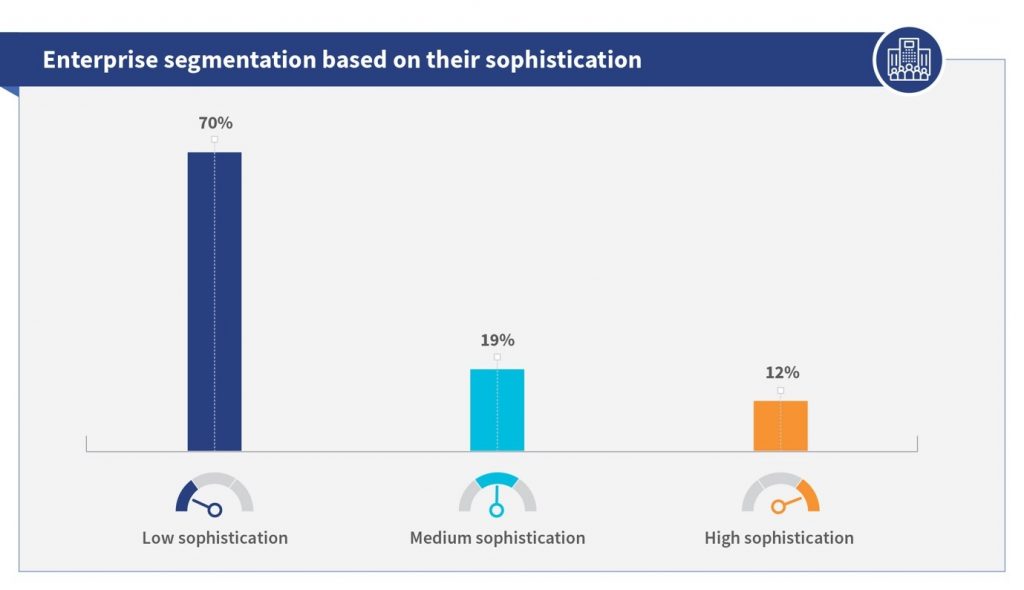
The categorization is based on how enterprises function. Yet it also highlights how well these enterprises perform business operations and access financial services. Enterprises with low sophistication are run predominantly by women with low levels of education and are concentrated in rural areas. On average, these enterprises pay lower wages to their employees than their more sophisticated counterparts. Entrepreneurs managing high-sophistication enterprises have better internet access and use mobile money more frequently.
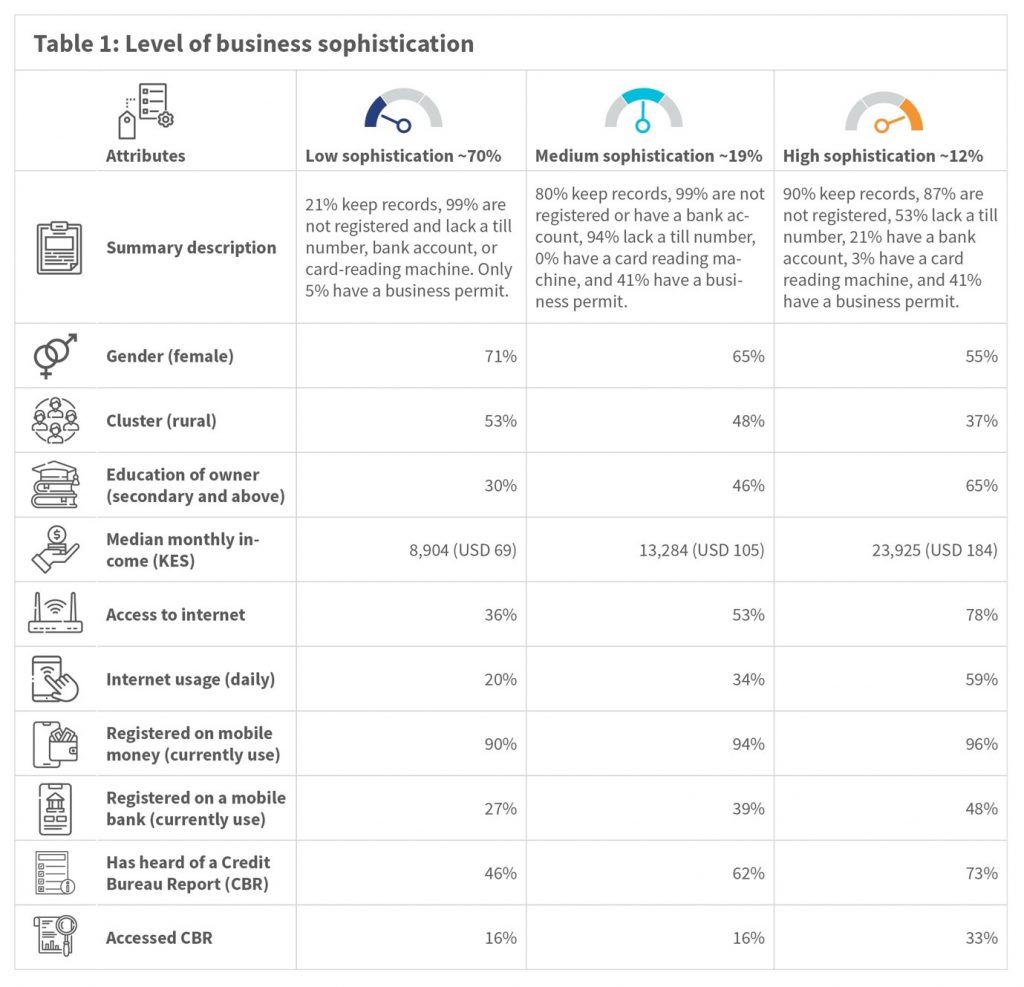
Source of savings and credit
Business sophistication also directs how these enterprises manage and access their finances. A more sophisticated enterprise is more likely to access its Credit Bureau Report (Table 1) and save with formal channels or avenues, such as banks, and mobile money.
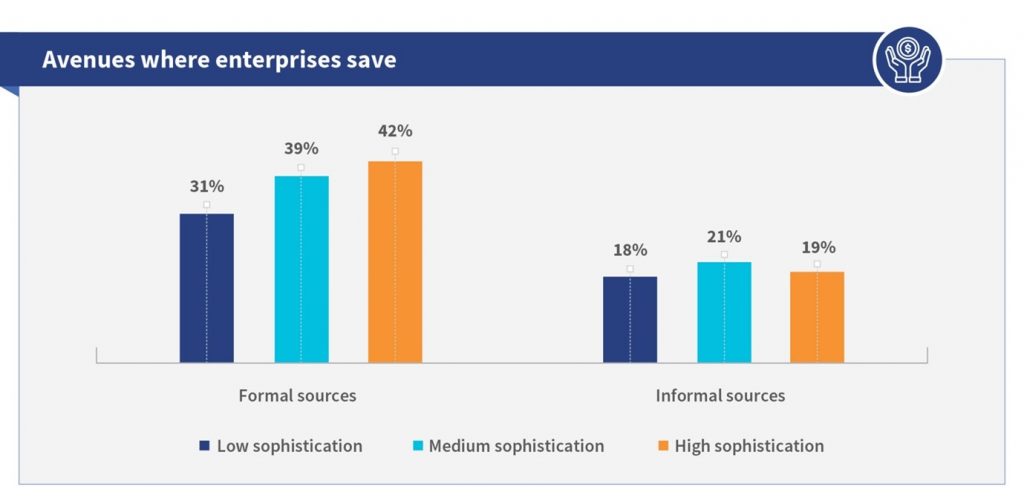
Enterprises with higher sophistication were more likely to use formal sources of credit than less sophisticated enterprises. Lack of collateral and financial records are among the reasons for the exclusion of these enterprises. The lack of credit from formal sources stifles the growth of all categories
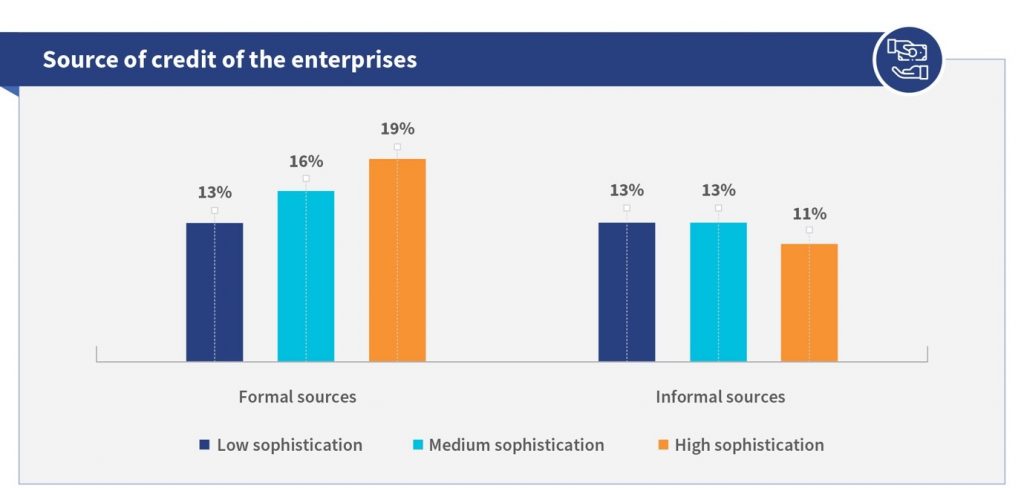
Financial resilience of enterprises
Findings from the FinAccess Household Survey also suggested low financial resilience of the enterprises, irrespective of their sophistication. Major unforeseen events, such as the pandemic itself, highlight the need for enterprises to have access to financial services to help manage risks and short-term adversity. Our June 2020 report on the “Impact of the COVID-19 pandemic on MSMEs” discusses how the pandemic significantly hurt the income of these businesses and disrupted supply chains and cash flows. About 6% of enterprises used formal borrowing and saving channels to cope with the shocks, while 22% relied on assistance from friends and families. However, the various segments displayed minor differences. More sophisticated businesses were better placed than the others to use formal savings and credit to manage shocks.
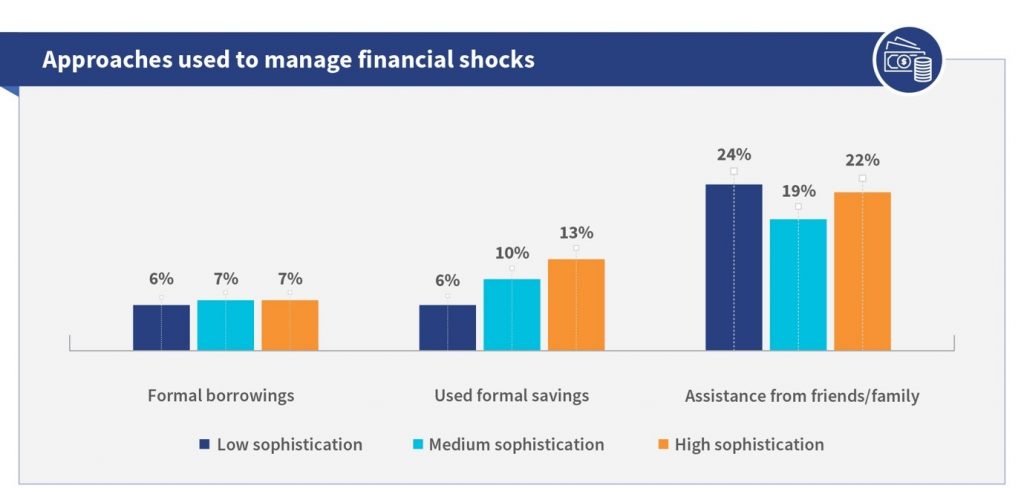
Access to banking products
Most entrepreneurs were keen on insurance and pension facilities but cited affordability as a significant hurdle. Less sophisticated businesses were least likely to afford the insurance coverage they wanted. A report by UNCTAD discusses how insurance coverage for enterprises still largely remains a distant aspiration. The affordability of pension schemes is similarly challenging for all business owners. Barriers associated with product design, distribution channels, and a lack of insurance culture require collective participation from the public and private sectors to overcome.
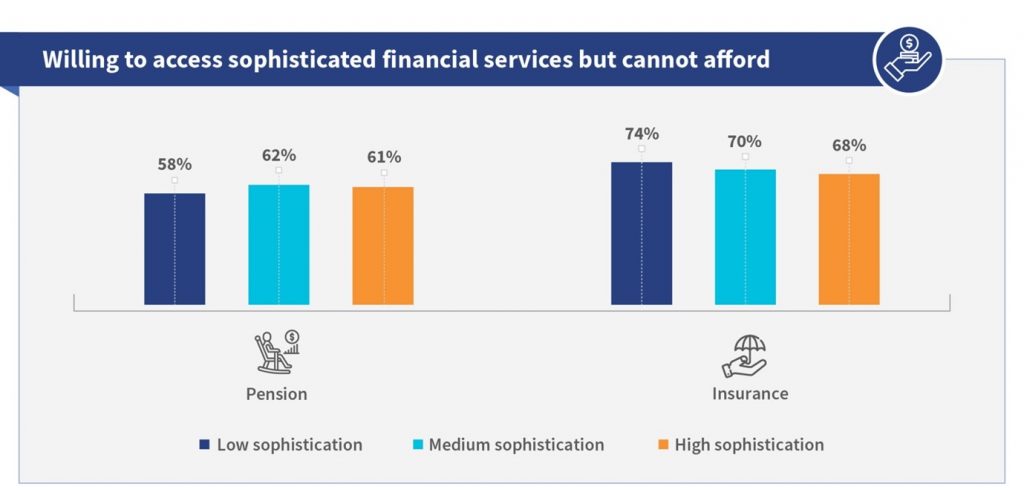
The segmentation analysis makes the challenges faced by enterprises more distinct. More details about the operations of the different categories of enterprises will provide an even clearer picture on the challenges faced, and needs and aspirations of the enterprises. For example, many challenges are seasonal, while others have more predictable and consistent course. Nevertheless, the segmentation analysis helps us understand the enterprises better and makes strategizing for immediate response to ensure short-term survival and build their resilience for the long term easier.
Mobile money agents: Sustainability in the digital era—findings from Mozambique
This report assesses pressing challenges that affect Mozambican mobile money agents: poor liquidity management, low working capital, and network issues. These challenges threaten the agents’ business and thus reverse the already realized gains in financial inclusion in the country.
The insights from this report will inform agent network ecosystem players in Mozambique to create sustainable strategies to maintain and expand agent networks.
Read this report for more details.

